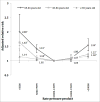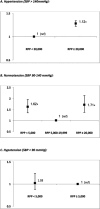Association of Early Myocardial Workload and Mortality Following Severe Traumatic Brain Injury
- PMID: 29509569
- PMCID: PMC5953788
- DOI: 10.1097/CCM.0000000000003052
Association of Early Myocardial Workload and Mortality Following Severe Traumatic Brain Injury
Abstract
Objectives: To examine the impact of early myocardial workload on in-hospital mortality following isolated severe traumatic brain injury.
Design: Retrospective cohort study.
Setting: Data from the National Trauma Databank, a multicenter trauma registry operated by the American College of Surgeons, from 2007 to 2014.
Patients: Adult patients with isolated severe traumatic brain injury (defined as admission Glasgow Coma Scale < 8 and head Abbreviated Injury Score ≥ 4).
Interventions: Admission rate-pressure product, categorized into five levels based on published low, normal, and submaximal human thresholds: less than 5,000; 5,000-9,999; 10,000-14,999; 15,000-19,999; and greater than 20,000.
Measurements and main results: Data from 26,412 patients were analyzed. Most patients had a normal rate-pressure product (43%), 35% had elevated rate-pressure product, and 22% had depressed rate-pressure product at hospital admission. Compared with the normal rate-pressure product group, in-hospital mortality was 22 percentage points higher in the lowest rate-pressure product group (cumulative mortality, 50.2%; 95% CI, 43.6-56.9%) and 11 percentage points higher in the highest rate-pressure product group (cumulative mortality, 39.2%; 95% CI, 37.4-40.9%). The lowest rate-pressure product group was associated with a 50% increased risk of mortality, compared with the normal rate-pressure product group (adjusted relative risk, 1.50; 95% CI, 1.31-1.76%; p < 0.0001), and the highest rate-pressure product group was associated with a 25% increased risk of mortality, compared with the normal rate-pressure product group (adjusted relative risk, 1.25; 95% CI, 1.18-1.92%; p < 0.0001). This relationship was blunted with increasing age. Among patients with normotension, those with depressed and elevated rate-pressure products experienced increased mortality.
Conclusions: Adults with severe traumatic brain injury experience heterogeneous myocardial workload profiles that have a "U-shaped" relationship with mortality, even in the presence of a normal blood pressure. Our findings are novel and suggest that cardiac performance is important following severe traumatic brain injury.
Conflict of interest statement
Conflicts of Interest: None
All authors report no potential conflicts of interest.
Figures


Comment in
-
Brain Injured and Heart Strained.Crit Care Med. 2018 Jun;46(6):1023-1024. doi: 10.1097/CCM.0000000000003096. Crit Care Med. 2018. PMID: 29762407 No abstract available.
Similar articles
-
Impact of Glasgow Coma Scale score and pupil parameters on mortality rate and outcome in pediatric and adult severe traumatic brain injury: a retrospective, multicenter cohort study.J Neurosurg. 2017 Mar;126(3):760-767. doi: 10.3171/2016.1.JNS152385. Epub 2016 Apr 1. J Neurosurg. 2017. PMID: 27035177
-
Association of Angiotensin-Converting Enzyme Inhibitors with Increased Mortality Among Patients with Isolated Severe Traumatic Brain Injury.Neurocrit Care. 2019 Dec;31(3):507-513. doi: 10.1007/s12028-019-00755-y. Neurocrit Care. 2019. PMID: 31187434
-
Association Between Admission Systolic Blood Pressure and Outcomes in Patients with Isolated Traumatic Brain Injury: A Cross-National Multicenter Cohort Study.J Neurotrauma. 2024 Dec;41(23-24):2590-2601. doi: 10.1089/neu.2023.0392. Epub 2024 Sep 30. J Neurotrauma. 2024. PMID: 39264870
-
Association of skull fracture with in-hospital mortality in severe traumatic brain injury patients.Am J Emerg Med. 2021 Aug;46:78-83. doi: 10.1016/j.ajem.2021.03.020. Epub 2021 Mar 11. Am J Emerg Med. 2021. PMID: 33740570
-
Clinical Epidemiology of Adults With Moderate Traumatic Brain Injury.Crit Care Med. 2018 May;46(5):781-787. doi: 10.1097/CCM.0000000000002991. Crit Care Med. 2018. PMID: 29369057 Free PMC article.
Cited by
-
A pilot study evaluating a simple cardiac dysfunction score to predict complications and survival among critically-ill patients with traumatic brain injury.J Crit Care. 2019 Dec;54:130-135. doi: 10.1016/j.jcrc.2019.08.017. Epub 2019 Aug 8. J Crit Care. 2019. PMID: 31446230 Free PMC article.
-
Prognostic Value of Nighttime Double Product in Nondialysis Chronic Kidney Disease With Hypertension.J Am Heart Assoc. 2023 Dec 19;12(24):e031627. doi: 10.1161/JAHA.123.031627. Epub 2023 Dec 18. J Am Heart Assoc. 2023. PMID: 38108241 Free PMC article.
-
Admission rate-pressure product as an early predictor for in-hospital mortality after aneurysmal subarachnoid hemorrhage.Neurosurg Rev. 2022 Aug;45(4):2811-2822. doi: 10.1007/s10143-022-01795-3. Epub 2022 Apr 29. Neurosurg Rev. 2022. PMID: 35488072
-
Multiorgan Dysfunction After Severe Traumatic Brain Injury: Epidemiology, Mechanisms, and Clinical Management.Chest. 2021 Sep;160(3):956-964. doi: 10.1016/j.chest.2021.01.016. Epub 2021 Jan 16. Chest. 2021. PMID: 33460623 Free PMC article. Review.
-
The rate-pressure product combined model within 24 h on admission predicts the 30-day mortality rate in conservatively treated patients with intracerebral hemorrhage.Front Neurol. 2024 Jun 7;15:1377843. doi: 10.3389/fneur.2024.1377843. eCollection 2024. Front Neurol. 2024. PMID: 38911585 Free PMC article.
References
-
- Rutland-Brown W, Langlois JA, Thomas KE, et al. Incidence of traumatic brain injury in the United States, 2003. J Head Trauma Rehabil. 2006;21(6):544–8. - PubMed
-
- Zafar SN, Millham FH, Chang Y, et al. Presenting blood pressure in traumatic brain injury: a bimodal distribution of death. J Trauma. 2011;71(5):1179–84. - PubMed
-
- Butcher I, Maas AI, Lu J, et al. Prognostic value of admission blood pressure in traumatic brain injury: results from the IMPACT study. J Neurotrauma. 2007;24(2):294–302. - PubMed
-
- Carney N, Totten AM, O'Reilly C, et al. Guidelines for the Management of Severe Traumatic Brain Injury, Fourth Edition. Neurosurgery. 2016 - PubMed
MeSH terms
Grants and funding
LinkOut - more resources
Full Text Sources
Other Literature Sources
Medical

